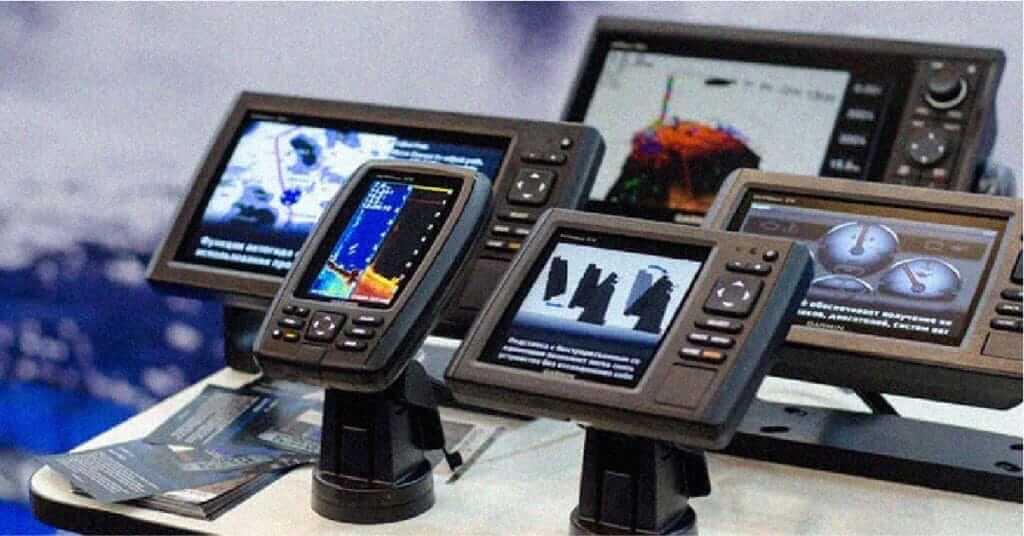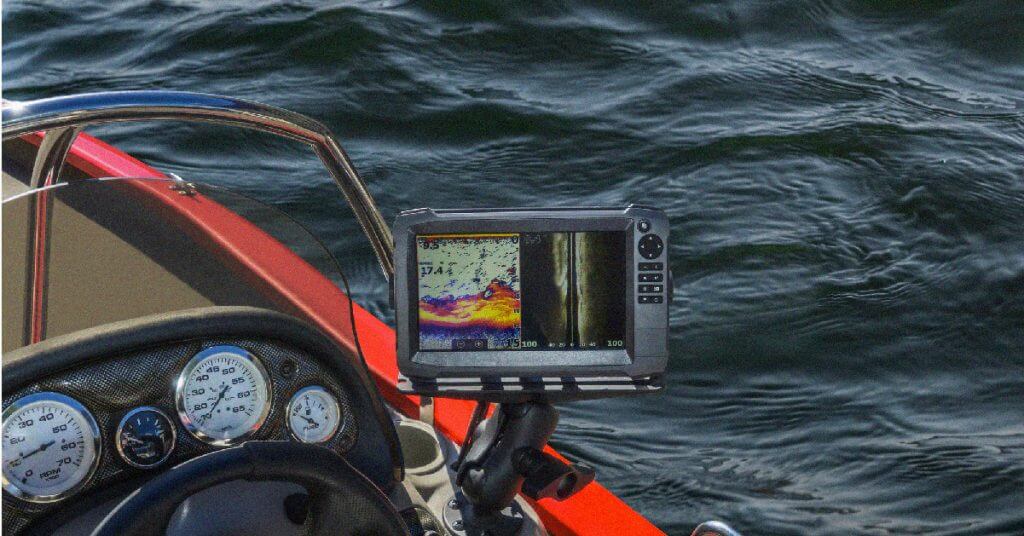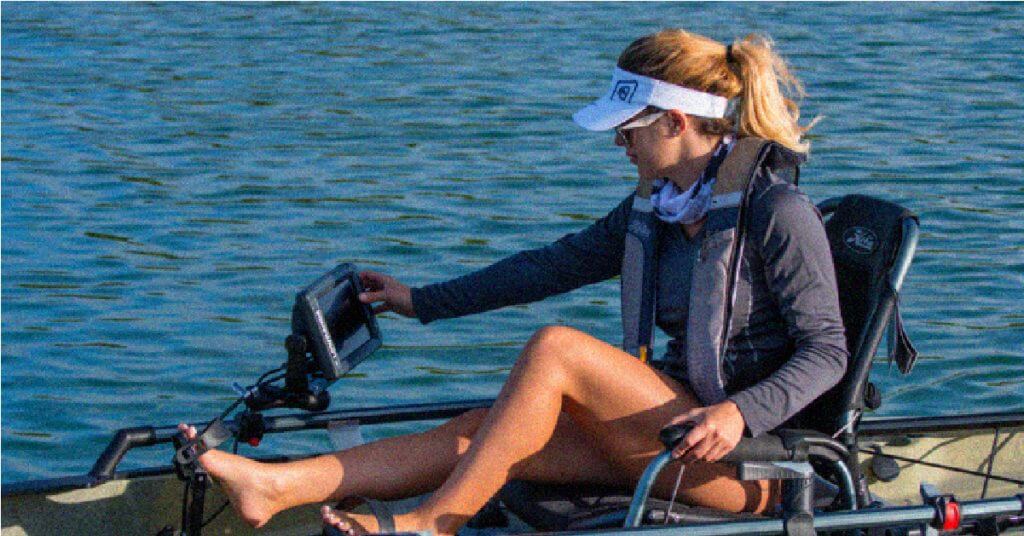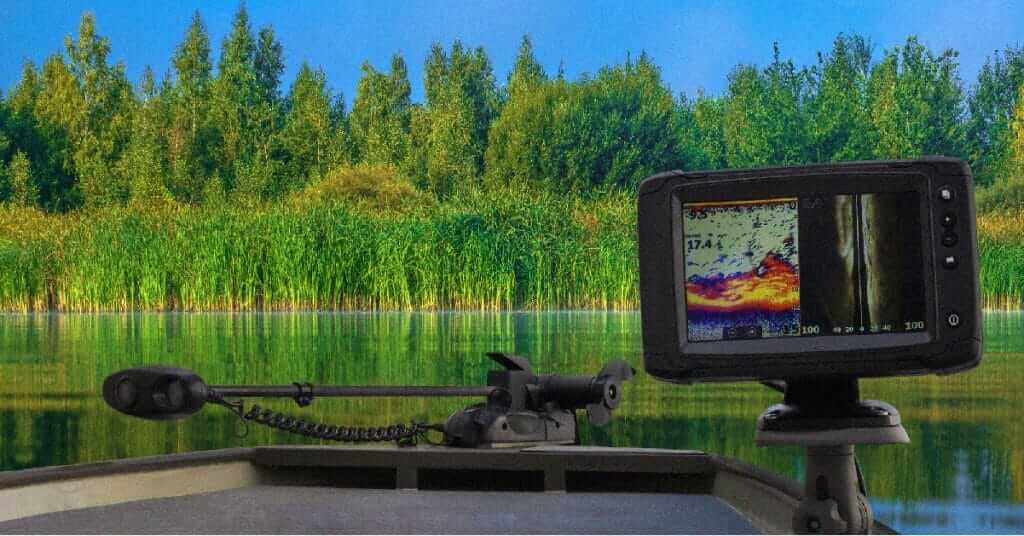We independently research, test, and recommend the best products; you can learn more about our review process here.
The down imaging vs. side imaging fish finder is a debate that very few people understand.
Both down and side imaging fish finders have their differences and similarities but people tend to think that one is “better” than the other.
That’s not really the case.
They’re two completely different types of sonar to help you detect fish under the water and they do it in very different ways.
I hope by the end of this guide you fully understand the advantages and disadvantages of down imaging and side imaging fish finders.
What is Down Imaging?

Down imaging fishfinders will display images of everything that is happening directly beneath your boat.
The transducer sends sonar waves under the boat which provides you with a solid idea of where fish and structure are located underneath you and partially in front and behind you.
A majority of fish finders you find on the market will be down imaging because they typically come at a cheaper cost, they’re simpler to use, and they’re more popular with smaller fish such as bass and panfish.
If you research down imaging fish finders you’ll often hear terms like “DownVu,” “DownScan,” or “DI.”
These all tell us that the fish finder is a down imaging device that will display live imaging of what’s happening under the boat.
What is Side Imaging?

A side imaging fish finder allows you to scan the water horizontally on each side of you.
This helps you quickly scan the water because you’re capable of looking in two places at once.
That said, side imaging fish finders aren’t always the best choice for locating smaller fish because most people use them with trolling motors which makes it easier to cruise by schools without noticing them.
Where side scan fish finders are most used is in shallow water because this is where they pick up well on fish since you can read both sides of the water.
If you’re moving through a river or creek, these are a great choice.
Side Imaging vs Down Imaging
The main difference between side imaging and down imaging fish finders is that down imaging fish finders read the water vertically while side imaging fish finders do so horizontally.
These differences might not seem like a big deal or that they would even have a difference at all, but it’s important that you understand how to read your fish finder so you can increase your chances of success on the water.
Advantages of Down Imaging
- These fish finders are more useful for deep water. Since you’re scouring the water for fish on a vertical level rather than a horizontal plane, looking for fish with down imaging is better in deeper water.
- Down imaging typically produces higher quality images when traveling at high speeds. If you’re trying to cover a lot of water in a short amount of time, down imaging is the way to go.
- While this isn’t always the case, I think down imaging fish finders are more affordable. If you’re trying to get a GPS fish finder combination, many of them will offer down imaging and this is the most affordable way to get the most features in your fish finder.
Disadvantages of Down Imaging
- These fish finders rely on a single transducer which means you won’t get as much information about what’s happening in the water. This can also result in lower-quality images with less resolution.
- As you can expect, since it’s vertical images, you won’t get horizontal information like a side imaging fish finder so you’ll only be able to see what’s underneath you. It’s counterintuitive to the fact that down imaging provides faster results because you’ll still have to cover more water if you plan on getting accurate images of everything.
- Even though they’re more affordable, there are a lot cheaper down imaging models because side imaging is a premium feature. This increases the chances of you purchasing a bad product and having to send it back.
Advantages of Side Imaging
- When you’re using a side imaging fish finder you can scan more water because you’re scanning in two separate directions. Keep in mind that you’ll have more than one transducer which means you can see what’s happening on both sides of the water.
- Better yet, if you get a side imaging fish finder it almost always comes as a premium offering to the down imaging one so you’ll get down imaging too. This means you’ll be able to toggle between the two to get the most accurate and up to date idea of what’s happening around you. It makes it impossible to miss anything.
- Since you’re getting a better point of view compared to down imaging it often results in clearer picture quality. This can also be true based on the speed of the boat since you have to move slower with side imaging.
- I think side imaging fish finders are the best choice in shallow water because they pick up a better reading since they can’t go as deep as down imaging scanners. This means that they work exceptionally well in rivers. If the river you’re fishing is small enough, you might even be able to fully scan the water without having to make a trip up and down each side.
Disadvantages of Side Imaging
- These types of fish finders are always more expensive because they usually come as a premium upgrade. If you have a side imaging fish finder you almost always have a down imaging one as well. There are some that you can buy as down imaging and then purchase additional transducers and upgrades to make it a side imaging fish finder.
- Side imaging doesn’t provide a high-quality picture of what’s going on beneath the boat. I find this to be a huge downside because I personally believe that side imaging fish finders don’t have the necessary depth you need to be able to see what’s happening unless you’re fishing very shallow water of 10 feet or less.
- Side imaging requires you to travel at a slower speed because they require more time to develop a proper image. This could be a good or bad thing. Slowing down the motor and taking your time may result in your locating something that you might have missed before. It all depends on the range of your fish finder.
Is One “Better” Than The Other?

Both of these fish finders have their purpose with pros and cons. They operate differently and I find that they work best when put together. That’s the reason why I recommend buying a down imaging and side imaging combo whenever possible if you can afford it. Sometimes you’ll see these referred to as “dual scan” or “triple threat” on Amazon by brands like Garmin, Humminbird, and Lowrance HDS.
Chirp is another word you’ll see a lot and that applies to both types of fish finders. It refers to the type of 2D sonar fish finding technology. It’s a continuous flow of sonar technology sent into the water from the sonar unit.
To decide which one is right for you, you must consider where you fish and how you fish there. If you’re the type of angler who spends most of his or her time in shallow rivers, downscan will almost do you no good.
The water will be too shallow and you’ll care so much more about what’s going on in areas that you can access with the boat.
If you’re staying still a lot more in deeper water and waiting for the fish to come to you, you’ll get away with just a downscan fish finder and you won’t have to worry about side imaging. This way, you can just stay where you are and let the sonar work its magic.
If ice fishing is your game, down imaging is the most popular type of fish finder simply because you’ll want to read the water directly beneath where you plan to drill your hole. Side imaging won’t do you any good and most of them won’t even be able to work properly with the ice.
Frequently Asked Questions
I can agree that it’s hard to understand which fish finder you should choose for your situation. Hopefully, this helps answer some of your questions!
Side imaging vs. down imaging for trolling?
If you spend most of your days on the water with a troll rod, you’ll need a side imaging fish finder. Side imaging is the ideal choice when you’re moving at a slow but steady pace. Plus, you’re getting images on both sides of the boat so you don’t have to fish in only one direction.
What does down imaging sonar and side image sonar mean?
Sonar simply refers to the way the sonar waves penetrate the water and bounce off of things. That’s what your fish finder does. It saves ultrasound waves into the water and they continue until they hit something. Then the result is displayed on the screen as an obstruction. It’s up to you to then determine if it’s weeds, a stump, or a fish.
Over time, fish finders have gotten much better at making that determination for us though.
Should I use side imaging or down imaging on a kayak?
The best kayak fish finder really depends on how you fish. If you need to scan a large amount of water on both sides, you’ll want a side imaging device. Chances are you’re fishing shallow backwater ponds and rivers with a kayak. If that’s the case then you’ll benefit from side imaging as well. Just keep in mind that they’re more expensive.
Can you use side imaging sonar to pick up on structure?
Some fish finders like the Humminbird Helix 5 have something called “structurescan.” This is different from traditional sonar and it helps you identify structure. Not every fish finder can do that.
Final Thoughts
By this point, you should clearly understand the differences and similarities between these two types of sonar. In reality, you could easily get by with either of these. Side imaging is an upgrade but it’s not necessarily “better.”
Think of it more as, “in addition to.” Side imaging is beneficial because it provides you with more flexibility in terms of your imaging but that doesn’t make it “better.”
It’s like comparing apples to oranges. I hope this squashes the down imaging vs. side imaging debate and helps shed a little light for you. Good luck and happy casting!





Awesome thanks alot.
I’m glad this was able to help you!!! 🙂
Terrific article. I read several others and was more confused. I fish mostly creeks and rivers and your answer on that was crystal clear.
Hey Roscoe, thanks so much – I really appreciate that! Thanks for reading
Très bon article!
Merci!
This helped me immensely. I was totally confuse. I’m just getting back into fishing and the technology has greatly changed. Thank you.
Comments like these really make my day so thank you. Fish finding technology keeps getting more and more complicated but I’ll be honest, a lot of the fancy features in many of these new fish finders are totally unnecessary. Sometimes sticking to the basics works best!
How far from the boat does “side imaging” extend????? Just wondering about hooking one up on the dock I fish from???????
It extends 23ft. With a 6ft. wide by 15ft. long “T” on it, meaning my rod is at 29ft. from shore, & if side imaging can add 25ft. more, I would know how deep to fish!!!!!!
Hey John, how far the side imaging extends depends on your unit! It’s hard for me to say without knowing what fish finder you have. Some offer ranges up to 150-200 feet. Check out our guide on the best fish finders if you’re looking to increase your range. Thanks for reading!
Thank you so much. This was great help.
Thank you!
Is Side Imageing better than Down Imageing??? Are U kidding me!?! Compareing S.I to D.I is like compareing Nascar to F1? When it comes to Freshwater Fishing, D.I offers very little in comparison, where the only combination 2seriously consider is “2D Sonar + S.I” and simply skip D.I & any combo views thereof altogether in order 2maximize your time on the water.
However, the only point this article made that I could “partially” agree with would pertain 2thoughts expressed where D.I. would be more helpful in DeepWater Fishing conditions and when I say this – it would pertain strictly to Saltwater Fishing ONLY as 1 must consider the amount of RMS Power required 2maintain consistent S.I readings due 2the increase in Density.
Now with that being said, Saltwater Fishing by it’s very nature usually means Deeper Water than the vast majority of Freshwater Fishing condititions the Avg Fisherman will encounter.
Saltwater Fishing is the 1 and only place where D.I “might be” more useful (perhaps “reliable” might be a better word) than S.I. and other than that, S.I. is hands down, beyond a shadow of a doubt, superior to D.I. in just about any/every aspect imaginable – especially when it comes to Freshwater Fishing.